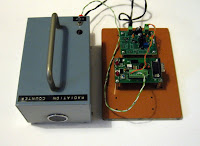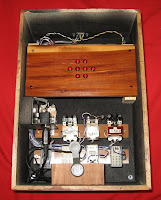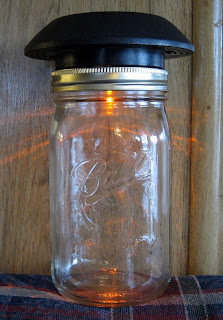
With all the interest of nuclear fallout from the reactors in Japan, I decided to get out my geiger counter that I made over 20 years ago. I thought it would be fun to Ustream the data from the counter. My counter has a optocoupler that makes a digital pulse everytime a particle is detected. To stream the data, some kind of presentation is needed to show on Ustream.
Free and useful programs are always welcomed. So I searched the web for a geiger counter grapher and logger. I found one that was suitable. Its called "Digital Geiger Counter" and can be found at Images Scientific Instruments. They have some nice kits for those who don't have a counter. The program connects to an interface at 9600 baud and receives a count for displaying inside the program. They also have instructions for building your own interface using a Pic MPU. I made mine with a Picaxe MPU instead. These are cheap pics that use Basic language for programming. You can get one from Sparkfun and the free compiler from Revolution Education.
Here is a drawing of my Picaxe Interface and program. Its very short and sends the count once a second to Digital Geiger Counter program through the RS232 link. For a more robust interface using a MAX232 use this drawing. You can also program the picaxe through both type of interfaces remotely. This makes it handy if the geiger counter is mounted outside.
To present the data using Digital Geiger Counter, you need a way to present your desktop on Ustream. You can use Ustream's Producer or Manycams as the presenter. Get a free Ustream account, connect your geiger counter and you got your own Web Station off and running. This is my Ustream Geiger Counter Channel. It may or may not be running all the time.
You can view an excel file of the first set of data that I started on Friday, 3-18-11, that ran all night to Saturday morning. Each data point is 1 minute as counts per minute (CPM). The counts seem pretty random and I didn't see any rise in the background radiation. So unless you have a blown reactor in your backyard, you may not see a rise of the background radiation. Here on the West Coast in the SF Bay Area, I'm not seeing a problem.
I also wrote an instructable on this project. You can view it here.
So if you got a geiger counter and can interface a logger to it, get it out and count those radioactive particles. Share with us your results.
Update 3-29-11 Plot of the Counts:
I plotted the CPM on 3-19 and 3-28 to compare value. Didn't see any change. You can download the excel file here.
Update 3-31-11 New Hardware with a PIC 12F675 and 16 mhz xtal.
Schematic: Interface3.pdf
Program in Pic Basic Pro: counter3.bas
HEX code for 12F675: counter3.HEX









